How to contribute
Registering
To be able to actively help with translations, you must create your own account. Note that Weblate publicly displays your profile and contributions.
Making suggestions
After you ‘ve registered, you can can start making suggestions:
-
Open the “H5P” project in Weblate by clicking on Projects –> Browse all projects. Then click on H5P in the list.
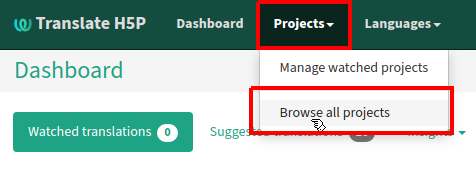
- Select the library you want to contribute to. The name of the libraries are mostly similar to the names of the H5P content types. For example “Fill in the blanks” is called “h5p-blanks”. In some cases there is a special editor library, too, e.g. “h5p-editor-course-presentation”.
- Select the language you want to contribute to. (If your language is not in the list, see Adding new translations below.)
-
You can now see the current status of all strings (texts) in the library:
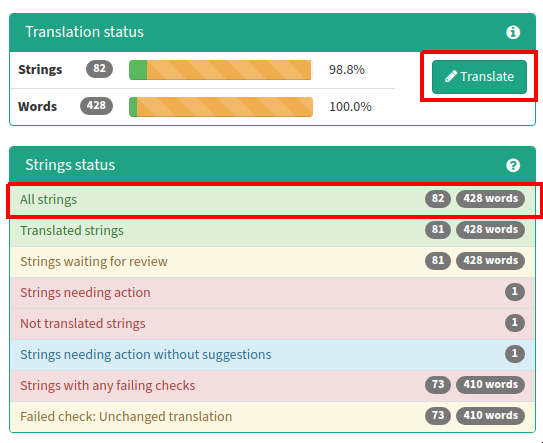
- If you simply want to translate all strings that require attention (because they are untranslated or have a warning), click on Translate.
- If you want to look through all string of the library click on All strings.
- Enter the translation into the box and press on the yellow Suggest button. The translation must now be reviewed by a maintainer.
- If a translation is fine as it is, you can either jump to the next translation by pressing Skip or by navigation with the arrow buttons at the top.
Becoming an editor
By default new users only have permission to make suggestions (to avoid abuse). For these suggestions to be accepted and submitted to the H5P repositories on GitHub, there needs to be an active editor for the respective language. Editors have further privileges:
- They can accept or edit suggestions.
- They can directly edit translations.
- They can pull (“download”) and push (“upload”) changes of libraries from and to GitHub.
Note: If you make suggestions to a language without an active editor, these suggestions will never find their way into H5P!
Becoming an editor is easy: Create your account and tell the site admins through the contact form that you want to become one. Please include:
- The name of your user account and your real name.
- What language you want to work on.
- What level of language proficiency you have in it.
Working as an editor
As an editor you can directly change translations without having to make suggestions.
If the translation of a library is finished, you can push the changes to GitHub. They will then be reviewed by Joubel and (hopefully) accepted:
-
Open the Repository maintenance page for the library you’re working on. To do this, click on Manage in the library’s overview page and then on Repository maintenance:

-
Click on the “push” on the right:
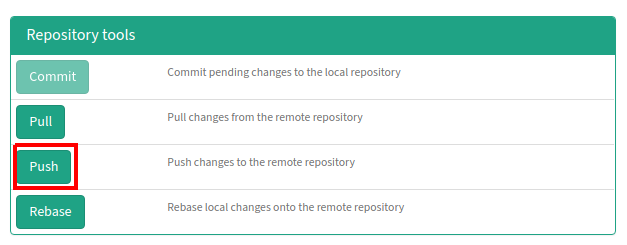
-
This will upload all the changes onto GitHub and create a pull request (a request asking Joubel to accept the changes).
Important: Only push single components and not the whole H5P project, as some libraries might be work in progress and at this time only have very few changes not worth pushing yet.
Important: As Weblate always pushes all language files for a library (“component”) you should avoid having “unfinished” language strings in the components: Other editors might push the component to GitHub because they’ve finished their translation and your “unfinished” work would be submitted, too. Weblate offers comments & suggestions for doing preliminary translations.
Adding new languages for libraries
If no-one has ever worked on translations of a specific library into your library, chances are high that there is no language file for the library yet. This means you’ll have to create one yourself:
- Navigate to the component list of the H5P project. Make sure you haven’t navigated to this list, by selecting your language first. In this case you’d only see the library which already have translations files!
- Click on the library you want to work on.
-
At the bottom of the list of already existing language, click on the button Start new translation:
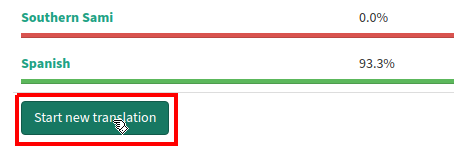
- Select your language from the list and click on Start new translation again.
Working with states
In Weblate every string can have three to keep track of which strings are already finished and which ones need work:
- Needs editing (red, automatically set for new strings or strings updated from outside)
- Ready for review (yellow, default, automatically set for auto-translations)
- Approved (blue, use this state to mark a string as finished)
Editors can change the state of a single string in the regular editor:
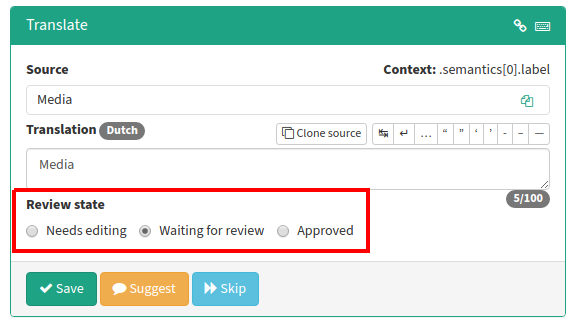
You can also change the state of all strings in a library in a special page, which you can reach from the overview page of a library’s language:
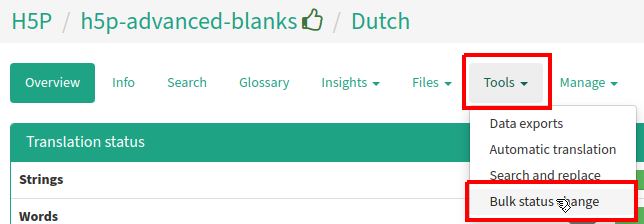
Glossaries
To improve consistency, Weblate supports glossaries. These are list of translations that translation conventions that translators should follow. A glossary consists of an English source string and the recommended translation. Whenever a translator encounters a string that contains the source string of a glossary item (even if it’s just a short part of it), the recommended translations will be automatically shown on the right:
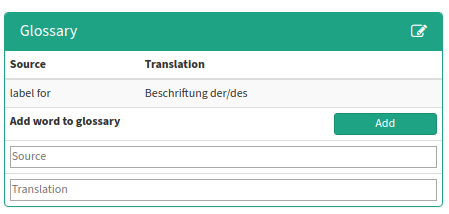
You can enter new glossary items in the same panel or by opening the whole glossary. To open the whole glossary, click on Glossary in a library’s overview page:

Dealing with problems
Should you have any problems, you can contact the administrators of this site through the contact form or ask on the H5P Translator’s forum.
Setting up GitHub webhooks (as a content type developer)
As Weblate internally keeps a copy of the Git repository of content types and has to merge changes in its repository with changes in the upstream repository, there can be merge conflicts if these repositories converge too much. A way of reducing these conflicts is to notify Weblate of changes in the upstream repository, so that it can immediately fetch these changes. GitHub allows repository owners to do this by setting up a webhook. If you are a content type developer, you are encouraged to add translate-h5p.tk as a webhook like you can see in the screenshot:
